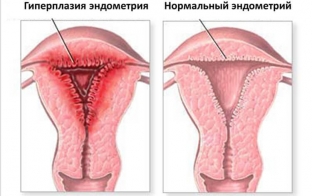Monthly blood loss – it is a physiological process that occurs in the body of every healthy woman of reproductive age. The female reproductive system functions in such a way that every month it prepares for fertilization, and if pregnancy does not occur, the mature egg and endometrium, ready to receive it, are separated and exit the uterine cavity in the form of menstrual blood. Such blood loss is physiological and does not threaten the woman's body with any negative consequences. But uterine bleeding that does not occur during menstruation is a sign of pathology. About dysfunctional uterine bleeding tells estet-portal.com.
Mechanisms of Dysfunctional Uterine Bleeding
Dysfunctional uterine bleeding is called acyclic bleeding from the uterus, resulting from a malfunction of the hypothalamic-pituitary-ovarian system. Such bleeding is not associated with organic changes in the female genital organs and indicates a malfunction in the female hormonal system. Dysfunctional uterine bleeding accounts for about 5% of all gynecological diseases that occur in the reproductive age and is one of the most common diseases of the female reproductive system. Blood loss on days when a woman does not expect menstruation is an alarming symptom, with which patients very often turn to gynecologists.
Dysfunctional uterine bleeding:
- etiological factors of dysfunctional uterine bleeding;
- mechanism of anovulatory dysfunctional uterine bleeding;
- mechanism of ovulatory dysfunctional uterine bleeding.
Etiological factors of dysfunctional uterine bleeding
Reason the occurrence of dysfunctional uterine bleeding are various disorders of the ovaries and the hypothalamic-pituitary system of a woman. The main etiological factors of acyclic uterine bleeding include:
- stressful situations;
- exposure to occupational hazards;
- mental and physical overwork of a woman's body;
- hypovitaminosis;
- intoxication and infectious processes in the body, including in the organs of the reproductive system;
- Hormonal homeostasis disorders;
- previously had abortions;
- taking certain medications.

Mechanism of anovulatory dysfunctional uterine bleeding
Depending on the clinical and morphological features and pathogenetic mechanisms, dysfunctional uterine bleeding of the reproductive period is divided into anovulatory and ovulatory. With dysfunctional uterine bleeding in the ovaries, follicle persistence most often occurs, followed by excessive production of estrogens. The prolonged effect of elevated estrogen levels on the uterus is the cause of the overgrowth of the endometrium. Due to congestive plethora, a sharp expansion of the capillaries in the endometrium and circulatory disorders, the uterine mucosa undergoes necrotic processes, resulting in a long-term uneven rejection of the endometrium – anovulatory dysfunctional uterine bleeding.
Mechanism of ovulatory dysfunctional uterine bleeding
Ovulatory dysfunctional uterine bleeding is due to the persistence of the corpus luteum. As a result of persistence, the concentration of progestogens rapidly decreases and remains at the same level for a long time. This provokes uneven rejection of the endometrium and prolonged menometrorrhagia. Bleeding is also facilitated by a decrease in the tone of the uterus under the influence of an increased content of progesterone in the blood of a woman. Normally, in the middle of the menstrual cycle, there is also a decrease in estrogen levels, but since the general hormonal background is supported by the corpus luteum – it does not cause bleeding. With a significant and sharp decrease in hormone levels, uterine bleeding can occur after ovulation and last for several days.







Add a comment